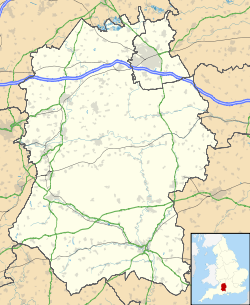- The Old Bell Hotel and Restaurant
-
The Old Bell Hotel and Restaurant 
Location in Wiltshire Location Cotswolds, Malmesbury, Wiltshire, England Coordinates 51°35′5″N 2°5′56″W / 51.58472°N 2.09889°W Opening date 1220 Rooms 33 Suites 8 Restaurants 1 The Old Bell Hotel and Restaurant is a hotel and restaurant on the edge of the Cotswolds in Malmesbury, Wiltshire, England. Built on the remains of outbuildings of Malmesbury Abbey, it lays claim to being the oldest existing hotel in England, standing on foundations dated to 1220, and is a Grade I listed building.[1][2] It is located in Abbey Row adjacent to the abbey, which was built to accommodate scholars studying at the abbey.[3] The bell of the inn sign refers to St Aldhelm's bell, the great bell in a peal of ten that once hung in the former west end tower of the abbey church, noted by John Leland's Itinerary[4] and in William Camden's Britannia.[5]
Contents
Architecture
Exterior
The inn has been extended and altered from a core built in 1220, probably by Abbot Loring, re-using material from the old keep built by Bishop Roger c1130, which had been demolished on the same site in 1216 by permission of King John.[6] An ashlar fire hood may be the earliest domestic ground-floor fireplace, served by a flue, surviving in England.[7] The abbey guest house was extended at the east end in the late 15th or early 16th century and the older structure partly refaced and reroofed. Following the dissolution of the monasteries, the house was referred to as the Steward's Lodging and was used for some time as weavers' lodgings: "every corner of the vast houses of office which belonged to the abbaye", Leland noted in 1540, "be fulle of lumbes to weve clothe yn"[8] The present roofline and dormers date to the 17th century, and the west extension was added in 1908.[7]
The Old Bell was listed as a Grade I listed building on January 28, 1949.[7] The inn was originally built in 1220 next to the abbey. In the late 15th century and early 16th century it was expanded, and partly refaced and reroofed. A cloth mill was added around 1530.[7] In 1908 it was again extended and reroofed.[7] The 4-bay inn is made from limestone rubble and dressings. Mullion windows are a feature of the inn and the front is heavily covered in vegetation. The inn has a central cross-axial stack, with a 16th century 2-bay extension and 2 large gable dormers on the east side.[7] The doorway here is dated to the 18th century with an architrave and shell hood. On the west side is the main porch and entrance.
Interior
The interior of the hotel and restaurant is luxurious and illustrates a fusion of styles from Medieval to Edwardian in the main building to Japanese in the coach house.[2] The hotel has 33 rooms and 8 suites with four poster beds and 3 single rooms. A prominent feature of the inn is a fine ashlar fire hood which is believed to be one of the earliest domestic-style ground-floor fireplaces, served by a flue, in England, dated to the initial building in 1220.[7] It was restored around 1980.
The central room to the first floor has a late 15th century and early 16th century compartmental ceiling with deeply moulded beams and 17th century dormers are cut through large trenched purlins.[7] The current stairway is relatively new, replaced some time after 1950.[7] A corridor connects the main building to the coaching house which has 6 rooms on the ground floor and several of the rooms are adjoining. Beneath the lounge to the inn is a vaulted cellar which has been reported to contain 8 stone coffins.[7] The dwarf walls with iron railings attached to the property are also part of the Listed Building property.[7]
The hotel and restaurant has been awarded the AA 3 Stars and AA 2 Rosettes.[9][10] The restaurant, which serves French cuisine, is run by executive chef Tony Rains, who has previously worked for Marco Pierre White and at Claridges.
Haunting
The hotel is reportedly haunted,[citation needed] with a great number of different apparitions reported, including "The Grey Lady" who is supposed to be the ghost of a woman who was unhappily married in the Abbey. Incidents such as glasses lifting by themselves and smashing against walls, wardrobes moving by themselves over the doors to impede entry into rooms and cold spots in the passageways have all been reported.
References
- ^ "The Archaeology of Wiltshire's Towns. An Extensive Urban Survey: Malmesbury" (PDF). Wiltshire County Archaeology Service. August 2004. http://ads.ahds.ac.uk/catalogue/adsdata/arch-906-1/dissemination/pdf/EUS_Texts/Malmesbury.pdf. Retrieved 1 March 2011.
- ^ a b Else, David (2005). England (3 ed.). Lonely Planet. p. 240. ISBN 1740599225. http://books.google.co.uk/books?id=euTXxqH-0ZIC&pg=PA240&dq=old+bell+malmesbury&hl=en&ei=e_4JTdnjM6mAhAfNl4HXDw&sa=X&oi=book_result&ct=result&resnum=2&ved=0CDUQ6AEwAQ#v=onepage&q=old%20bell%20malmesbury&f=false.
- ^ Andrews, Robert, Teller, Matthew (2004). The Rough Guide to Britain (5 ed.). Rough Guides. p. 322. ISBN 1843533014. http://books.google.co.uk/books?id=AOt1Hb8MOQUC&pg=PA322&dq=old+bell+malmesbury&hl=en&ei=3wEKTfucL8SChQf3k4jTDw&sa=X&oi=book_result&ct=result&resnum=1&ved=0CC4Q6AEwADgU#v=onepage&q=old%20bell%20malmesbury&f=false.
- ^ Leland, Itinerary ii.21, noted in Mackenzie Edward Charles Walcott, The Mitred Benedictine Abbey of S. Aldhelm, Malmesbury, a guide-memoir 1876:21.
- ^ Moffatt 1805:203.
- ^ "This castle stood a little to the north-west of the conventual church, partly on the spot at present called "The Abbey Row", noted John Marks Moffatt, The History of the Town of Malmesbury, and its Ancient Abbey (1805) citing William Camden, Britannia, p. 97; Moffatt adds the note "The Bell inn, thus situated, is stiled in a deed, "The Castle-House".
- ^ a b c d e f g h i j k "The Old Bell Hotel and Attached Front Area Walls and Railings, Malmesbury". British Listed Buildings. http://www.britishlistedbuildings.co.uk/en-460674-the-old-bell-hotel-and-attached-front-ar. Retrieved December 16, 2010.
- ^ Leland, quoted in Walcott 1876:35.
- ^ "Old Bell Hotel". The Automobile Association. http://www.theaa.com/hotels/malmesbury-old-bell-hotel-378089. Retrieved 23 February 2011.
- ^ "Guide to AA Ratings and Awards". The Automobile Association. http://www.theaa.com/travel/accommodation_restaurants_grading.html#stars. Retrieved 23 February 2011.
External links
Categories:- Hotels in Wiltshire
- Reportedly haunted locations in England
- 1220 architecture
- Public houses in Wiltshire
- Restaurants in England
- Grade I listed buildings in Wiltshire
- Malmesbury
Wikimedia Foundation. 2010.


